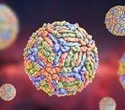
A recent study has discovered possible broad-spectrum antiviral drugs that can attack several families of RNA viruses, which continue to be a serious threat for pandemics in the future. Innate immune agonists that target pathogen recognition receptors were tested in the study, which was directed by Gustavo Garcia Jr. at UCLA’s Department of Molecular and Medical Pharmacology, and several agents showed promise, including one that had strong antiviral activity against RNA viral families.
Nearly seven million people have died as a result of the ongoing SARS-CoV-2 pandemic, which has highlighted how susceptible human society is to a widespread outbreak of new pathogens. The authors assert that recent epidemics as well as the overall climate can be used to precisely anticipate what would start the next pandemic.
These include such as Chikungunya virus (CHIKV), Dengue virus, West Nile virus and Zika virus. The researchers write: “Given their already-demonstrated epidemic potential, finding effective broad-spectrum treatments against these viruses is of the utmost importance as they become potential agents for pandemics.”
In their new study, published in Cell Reports Medicine, researchers found that several antivirals inhibited these arboviruses to varying degrees. “The most potent and broad-spectrum antiviral agents identified in the study were cyclic dinucleotide (CDN) STING agonists, which also hold promise in triggering an immune defense against cancer,” said senior author Vaithi Arumugaswami, Associate Professor in the UCLA Department of Molecular and Medical Pharmacology.
“A robust host antiviral response induced by a single dose treatment of STING agonist cAIMP is effective in preventing and mitigating the debilitating viral arthritis caused by Chikungunya virus in a mouse model. This is a very promising treatment modality as Chikungunya virus-affected individuals suffer from viral arthritis years and decades from the initial infection,” Arumugaswami added.





